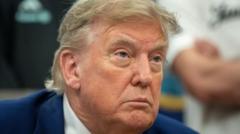The article discusses the implications of President Trump's tariffs on China's economy, highlighting challenges and changes that may arise in the manufacturing landscape.
**Trump's Tariffs: How They Could Impact China's Manufacturing Dominance**

**Trump's Tariffs: How They Could Impact China's Manufacturing Dominance**
US tariffs on Chinese imports face the potential to disrupt the manufacturing juggernaut of China amidst rising trade tensions.
As President Donald Trump imposes a second round of tariffs on Chinese imports, now at a minimum of 20%, the discourse around China's manufacturing dominance heats up once more. With the substantial trade surplus China has maintained—$1 trillion in 2024—these tariffs could seriously affect its economic health, which relies heavily on exports.
Tariffs, which are essentially taxes levied on imported goods, aim to incentivize Americans to choose domestic products, ultimately intended to bolster the US economy and safeguard jobs. Historical data shows that tariffs during Trump's first administration led to increased consumer prices, raising questions about their effectiveness. The recent tariffs target a swath of goods from electric vehicles to clothing, aiming to pressure China to take action against illegal drug trade issues affecting the US.
Economic forecasts indicate significant repercussions for China's exports, which contribute approximately 20% of its revenue. Analysts, including Harry Murphy Cruise, forecast drops in exports to the US by as much as a third, suggesting that the prolonged effects of tariffs may severely hinder China's trade surplus. Alicia Garcia-Herrero from Natixis asserts that to counteract these challenges, China needs to stimulate domestic demand, a daunting task amidst a struggling economy and a discontented workforce.
Despite the challenges posed by tariffs, analysts argue that halting China's manufacturing prowess is no easy feat. The country has advanced from its traditional garment production to areas such as robotics and artificial intelligence, solidifying its standing in high-value tech production—an advantage that could resist the threats from tariffs. China's status as a leading exporter, especially in solar panels, is difficult to rival.
In response to Trump's increasing tariffs, China has implemented counter-measures against US agricultural products and other commodities. The strategic adaptations include moving factories abroad and nurturing partnerships with countries like Vietnam to circumvent tariff burdens. However, analysts like Garcia-Herrero emphasize that while these tactics may alleviate some pressure, substantial US restrictions on advanced chips have ignited China's commitment to bolstering its own tech industry, culminating in competitive developments like AI chatbots.
China's rise to manufacturing preeminence can be attributed to government support, robust global supply chains, and a labor market long distinguished by low costs. As the geopolitical landscape shifts, Beijing is presented with an opportunity to redefine its role as a dominant advocate for free trade alongside rising trade tensions with the US. Navigating this volatile terrain will necessitate diversification beyond American markets while maintaining a vital trading relationship that benefits both economies.
Tariffs, which are essentially taxes levied on imported goods, aim to incentivize Americans to choose domestic products, ultimately intended to bolster the US economy and safeguard jobs. Historical data shows that tariffs during Trump's first administration led to increased consumer prices, raising questions about their effectiveness. The recent tariffs target a swath of goods from electric vehicles to clothing, aiming to pressure China to take action against illegal drug trade issues affecting the US.
Economic forecasts indicate significant repercussions for China's exports, which contribute approximately 20% of its revenue. Analysts, including Harry Murphy Cruise, forecast drops in exports to the US by as much as a third, suggesting that the prolonged effects of tariffs may severely hinder China's trade surplus. Alicia Garcia-Herrero from Natixis asserts that to counteract these challenges, China needs to stimulate domestic demand, a daunting task amidst a struggling economy and a discontented workforce.
Despite the challenges posed by tariffs, analysts argue that halting China's manufacturing prowess is no easy feat. The country has advanced from its traditional garment production to areas such as robotics and artificial intelligence, solidifying its standing in high-value tech production—an advantage that could resist the threats from tariffs. China's status as a leading exporter, especially in solar panels, is difficult to rival.
In response to Trump's increasing tariffs, China has implemented counter-measures against US agricultural products and other commodities. The strategic adaptations include moving factories abroad and nurturing partnerships with countries like Vietnam to circumvent tariff burdens. However, analysts like Garcia-Herrero emphasize that while these tactics may alleviate some pressure, substantial US restrictions on advanced chips have ignited China's commitment to bolstering its own tech industry, culminating in competitive developments like AI chatbots.
China's rise to manufacturing preeminence can be attributed to government support, robust global supply chains, and a labor market long distinguished by low costs. As the geopolitical landscape shifts, Beijing is presented with an opportunity to redefine its role as a dominant advocate for free trade alongside rising trade tensions with the US. Navigating this volatile terrain will necessitate diversification beyond American markets while maintaining a vital trading relationship that benefits both economies.





















